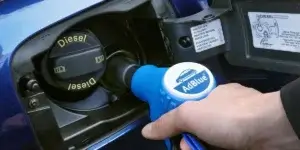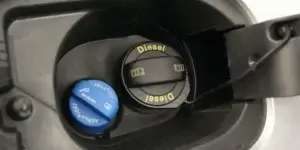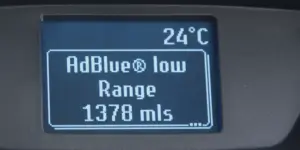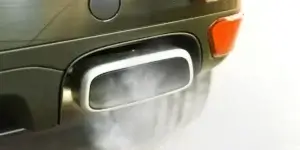What is AdBlue?
AdBlue is a liquid primarily used in diesel cars to reduce harmful emissions. It’s technically known as diesel exhaust fluid (DEF) and consists of a solution of distilled water and urea, a substance found in fertilisers. AdBlue is non-toxic, colourless, and has a slightly sweet smell. It may feel a bit sticky if you get any on your hands, but it washes off easily.

Why does a diesel car need AdBlue?
AdBlue helps to reduce emissions of nitrogen oxides (NOx) from a car’s exhaust. Euro 6 emissions standards, which apply to all cars built since September 2015, place strict limits on the amount of NOx that can be emitted legally. These emissions are a byproduct of the combustion process inside an engine that produces the power to drive a car.
Such emissions have been linked to respiratory conditions that can seriously affect people’s health. NOx emissions are a critical measure for deciding which cars can enter clean air zones, such as London’s Ultra Low Emission Zone (ULEZ), without paying a fee. Diesel cars registered after September 2015, which meet Euro 6 standard, are ULEZ-compliant and won’t be charged for entering.
How does AdBlue work?
AdBlue is used as part of a car’s selective catalytic reduction (SCR) system. It is automatically injected into the car’s exhaust system where it mixes with the exhaust gases, including NOx. The AdBlue reacts with the NOx and breaks it down into harmless substances like oxygen and nitrogen, which then disperse into the atmosphere.
While AdBlue doesn’t eliminate all of your car’s NOx emissions, it significantly reduces them, helping the vehicle stay within legal limits and contributing to cleaner air.

How much AdBlue will my car use?
There’s no fixed rate at which cars consume AdBlue. In most cases, it takes several thousand miles to empty the car’s AdBlue tank. Some vehicles can do at least 10,000 miles before needing a refill. Contrary to some misconceptions, using AdBlue doesn’t mean you’ll burn more fuel.
To better understand the maintenance of your vehicle, check out our guides on car maintenance.
How do I know how much AdBlue is left in my car?
All cars that use AdBlue have a gauge or display somewhere on the dashboard or in the trip computer showing how much is left. Consult your owner’s manual to find out how to view it. A warning light will show on the driver’s display long before the AdBlue tank becomes empty.
For more information on essential car checks, visit our guides on vehicle checks.

Can I refill the AdBlue myself?
Not every car allows you to refill the AdBlue tank yourself, but it’s easy to find out if yours does. Look for an extra filler with a blue cap for the AdBlue next to the regular diesel filler behind the fuel filler flap. The AdBlue tank is typically underneath the car, next to the fuel tank.
AdBlue is available from most fuel stations and car parts shops. It comes in containers of up to 10 litres, which usually cost between £15 and £20. The container typically includes a nozzle to make pouring the AdBlue into the filler much easier. Alternatively, fuel station HGV lanes have AdBlue pumps that you can use if your car has a suitable nozzle.
What happens if I put AdBlue in a diesel tank?
It’s crucial that you don’t accidentally pour AdBlue into your car’s fuel tank. Doing so will require the tank to be drained and flushed clean. Fortunately, you can’t put diesel in the AdBlue tank by accident because the pump nozzle is far too big.
If your car doesn’t have a dedicated AdBlue filler, the tank can only be refilled by a garage. Make sure the garage includes this service during regular maintenance. If the tank needs refilling between services, most garages will do so for a small charge.

What happens if my car runs out of AdBlue?
You should never allow your car to run out of AdBlue. If it does, the engine will go into ‘limp’ mode, drastically reducing power to keep NOx emissions within legal limits. A warning will appear on the driver’s display, and you should refill the AdBlue tank as soon as possible. Avoid turning off the engine until you have access to more AdBlue, as the engine is unlikely to restart without it.
Running out of AdBlue is just one of many reasons that an engine might go into limp mode. Severe problems with the engine or gearbox can also activate limp mode, designed to prevent further damage and keep the car moving to a safe place or a garage.
For more information on dealing with common car issues, visit our driving tips.
How do I reset an AdBlue warning?
If your AdBlue runs low and needs refilling, your car will flash up an alert either on the driver’s display or the infotainment system’s screen. Once you’ve filled the AdBlue tank to the recommended level, the warning should disappear. If it doesn’t, try driving for a few miles to allow the system to reset.
If the warning persists after driving, there could be a problem with the system or sensors. Check your car’s manual for guidance specific to your make and model. If the manual is unclear or the recommended steps have no effect, take your car to a mechanic.
Which cars use AdBlue in 2024?
Many diesel cars that meet Euro 6 emissions standards use AdBlue. However, not all of them do since other systems can also be used to reduce NOx emissions.
Here are some clues to help you figure out whether the car you want to buy uses AdBlue:
- Check whether the word ‘blue’ or the letters ‘SCR’ are part of the car’s name. For instance, Peugeot and Citroen diesels that use AdBlue are badged BlueHDi. Fords are badged EcoBlue. Volkswagens are badged TDI SCR.
- Open the fuel filler flap to see if there’s a blue-capped AdBlue filler. If you’re still unsure, ask the dealer or the manufacturer.
For more information on the best practices for car buying, check out our buying guides.

Do petrol cars use AdBlue?
No, petrol cars don’t need to use AdBlue. The NOx emissions that AdBlue neutralises are specific to diesel engines.
Is AdBlue harmful to the environment?
No, AdBlue isn’t harmful to the environment. It’s not toxic and isn’t flammable. If you spill it, you can just wipe it up or dilute it with water and mop it up.
However, avoid touching it as it can irritate your skin. It can also stain clothing and be mildly corrosive on some materials, including certain metals, plastics, and your car’s paintwork. If you spill any on your car, wipe it up quickly.
For more expert advice on car maintenance and eco-friendly driving, visit the Motors Advice Hub.


